“The secret of Zen lies in sitting, simply, in a posture of great concentration (…) Then deep and pure consciousness will appear—universal and limitless.” Taisen Deshimaru (1914–1982).
Zen Buddhism is essentially the practice of zazen: seated meditation with crossed legs, a straight back, and attention focused on the breath. Each person can experience silence and inner presence in the unity of body and spirit.
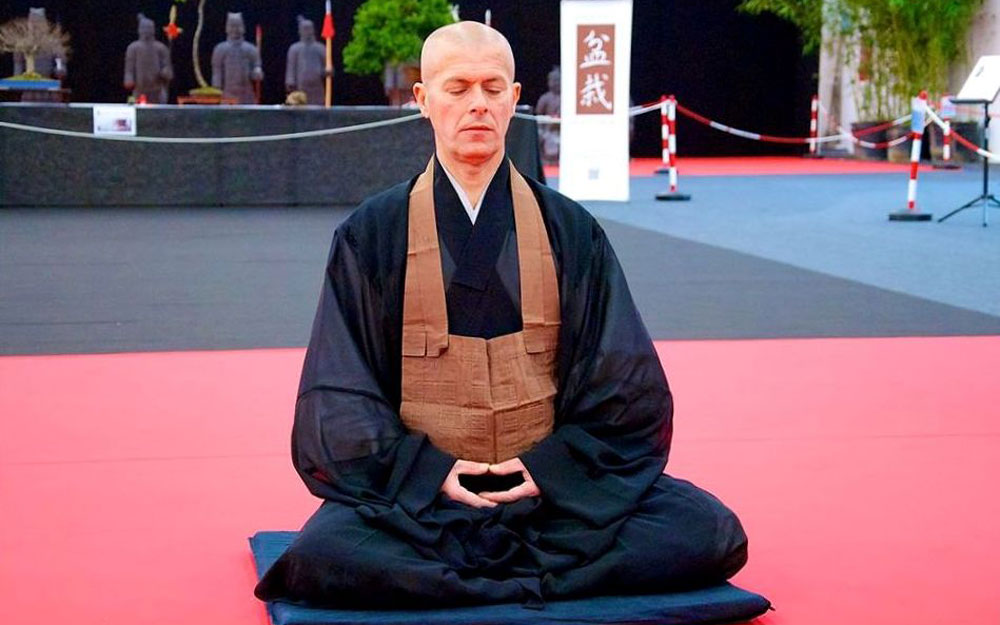
Zen Master Beppe Mokuza Signoritti in Meditation
Zazen is the meditation through which the Buddha came to understand the origin of suffering—and freed himself from it. “Don’t believe me on my word—experience it for yourselves!” was one of his first teachings, establishing the necessity of walking the Buddha’s Way firsthand.
Zazen is neither yoga, nor prayer, nor therapy. Zen Buddhism is not a knowledge derived from analysis or reasoning. It is an immediate practice, rooted in the present moment. The Zen experience goes beyond mere therapeutic or physical dimensions, as it concerns awakening. It differs from prayer in that it is not addressed to an external object.
Practicing Zen meditation means developing the full dimension of human existence, restoring beauty and dignity to life. Daily actions, whether noble or humble, unfold like the beads of a precious necklace. Each action is a treasure, giving meaning to the whole.
“Our exhalation is the exhalation of the entire universe. Our inhalation is the inhalation of the entire universe. In this way, in every moment, we carry out the Great Work without limits. To have this attitude means to dissolve all misfortune and create absolute happiness.” Kōdō Sawaki (1880–1965).
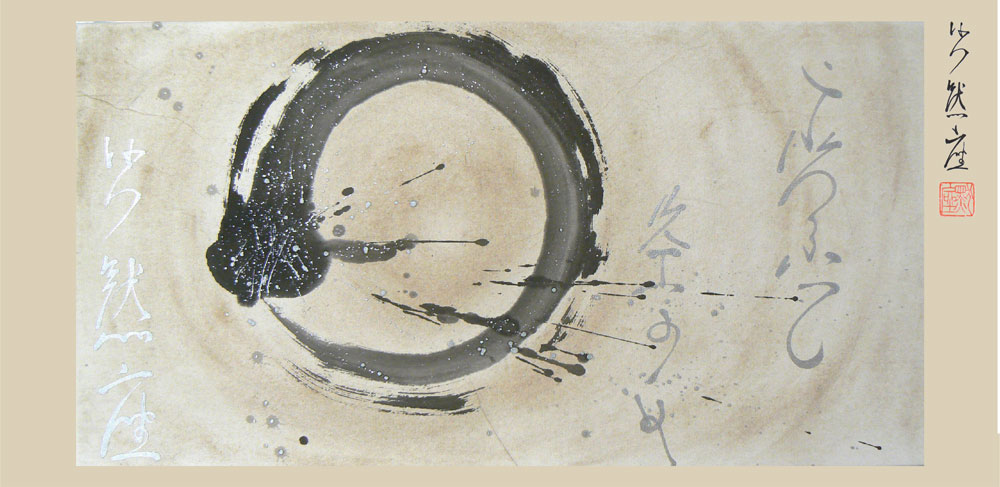
During meditation, correct breathing is essential.
It is calm and sets a slow, powerful, natural rhythm. Exhalation is long and deep—often compared by masters to the lowing of a cow. Inhalation happens naturally. The body is strengthened, the mind and circulation revitalized. This slow, calm, and deep exhalation clears away complications. The mind becomes serene like a cloudless sky.
By placing attention on posture and breathing, the mind returns to the body, achieving unity.
Thoughts no longer unfold in a continuous chain—they still appear, as is their nature, but if attention is maintained on posture, they vanish without leaving a trace. Naturally and unconsciously, personal will ceases to act or seek a goal. Only the present moment remains.
It is strongly recommended not to practice alone, but to seek guidance from an experienced person in a dojo (a place dedicated to zazen practice).
“In our restless world, practicing zazen means returning to the true dimension of human existence and rediscovering the fundamental balance of our lives.” Taisen Deshimaru (1914–1982).
Zazen influences our entire being—body and mind. With regular practice, our understanding of life deepens. This understanding then radiates into every daily action. When our mind remains in harmony with the present moment in all of life’s activities, our actions naturally become correct.
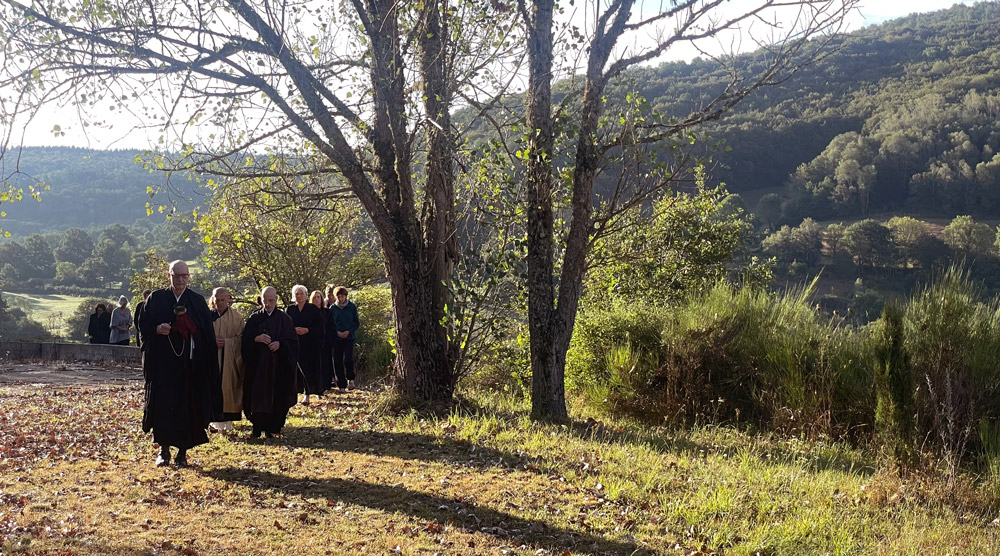
Kinhin Meditation in Nature
Our minds become calm—free of complications, calculations, or fear. Egoism diminishes, and we begin to follow the flow of cosmic life more naturally. In this way, our relationships with others become clearer, more transparent. Compassion arises. Wisdom appears. We are then able to devote ourselves to what is essential, and life becomes simple.
Zazen is the adult form of our life.
It is true happiness and authentic freedom.
Kin hin is the continuation of zazen while standing. It is practiced between two meditation sessions. This is a walking meditation guided by the breath, where concentration on every detail of posture is essential.
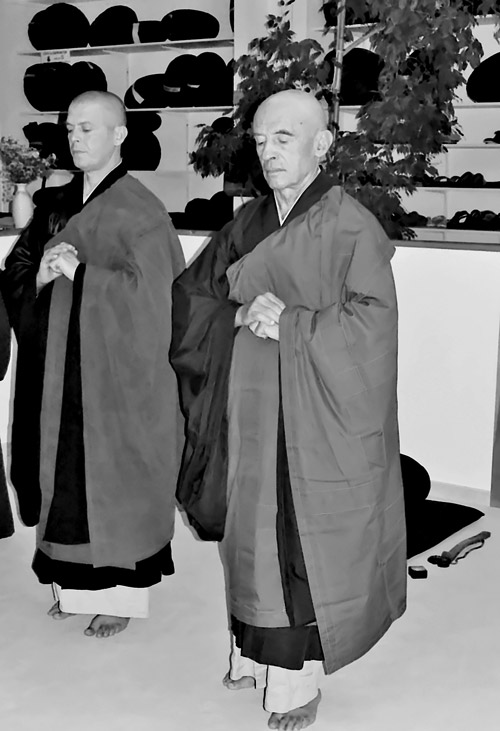
Kin hin
The left thumb is tucked inside the left fist and rests against the solar plexus. The right hand wraps around the left fist. The forearms are parallel to the ground. The back is straight, the chin slightly tucked in, the neck extended, and the gaze lowered.
Exhalation is long, deep, and silent; it expands below the navel and brings stability. At the end of the exhalation, the body naturally stretches, the inhalation happens effortlessly, and one steps forward by half a pace.
Kin hin develops dignity and presence. As with zazen, its repeated practice influences daily behavior and helps to restore balance and composure.
Samu is work performed with the concentration of zazen. All the masters of the Zen transmission, especially Master Hyakujo (720–814), emphasized the importance of samu.

Samu – Working with the concentration of zazen
Even at an advanced age, Hyakujo used to take part in the daily work in the fields alongside his disciples. One day, they hid his tools, thinking the master should rest. Hyakujo declared: “A day without work is a day without food.”
He stopped eating until the disciples returned his tools. In Zen, work is seen as something extremely valuable because it allows the practitioner to walk the Way through action. In a temple, the practice of zazen alternates with samu, which ensures both the sustenance and functioning of the temple and the organization of sesshin.
Zazen gives rise to great energy—how should it be used? For what purpose? Samu means making an effort without seeking any personal reward.
The Way of the Buddha is not studied externally, but through body and mind.
Zazen concludes with a ceremony. Every gesture in the ceremony—such as offering incense or chanting sutras—carries deep meaning. It is a prayer recited with the body. During the ceremony, there is no need to act based on thought.
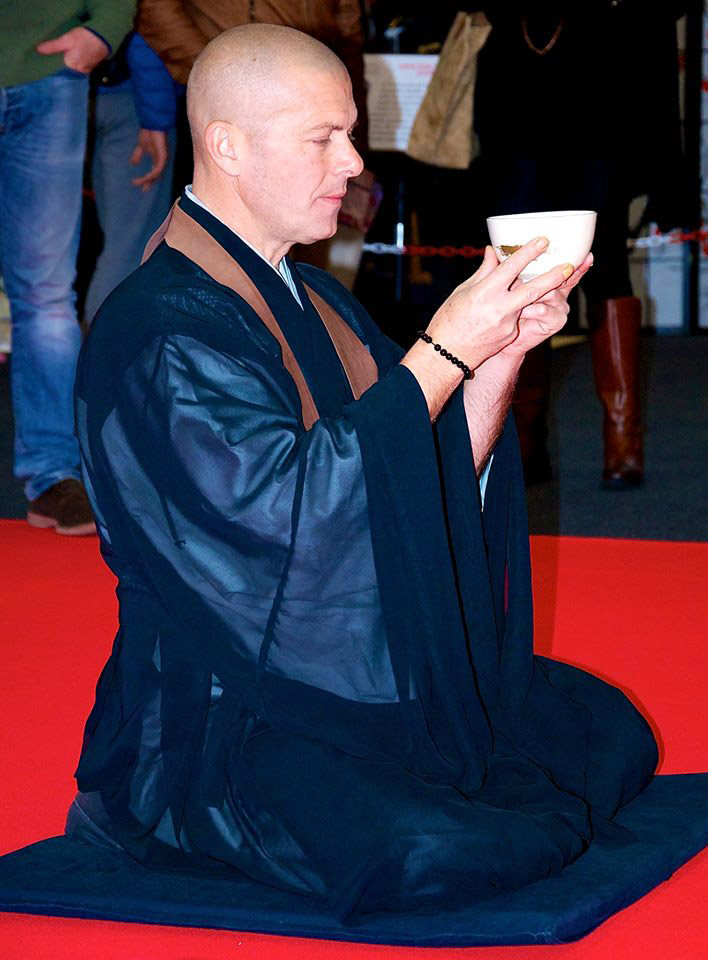
Zen Master Beppe Mokuza Signoritti
Without zazen, the ceremony would be mere formality, like a flower without fragrance. And yet, it gives practice a religious dimension, refines the spirit, and cultivates noble and sensitive behavior.
Manners shape the mind. Repeating the ceremony permeates the whole being and becomes a tool for deep inner education, one that continues into everyday life.
Both during the morning ceremony—following the meditation session—and at breakfast and lunch, students are invited to chant sutras from the Zen tradition.
Sutras are texts that record the teachings of the Buddha or ancient Masters.
In Zen, the sutras chanted after meditation are an expression of one’s practice – they are both intellectual understanding and energetic vibration.
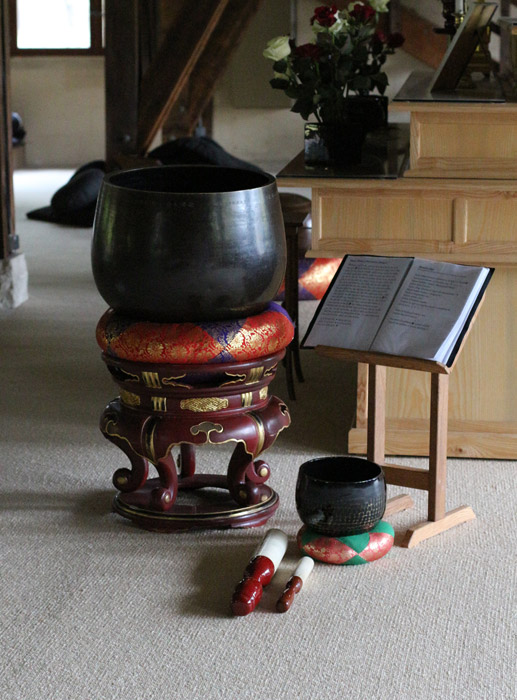
Bells for the ceremony
Chanting sutras, like zazen, means being One with others—abandoning ego and all sense of individuality.
Ceremonies are often dedicated “for the benefit of all beings.”
The texts are traditionally chanted in Sino-Japanese Sanskrit.
Using our whole body for the universe itself is our sacred practice. Using it only for the ego means doing no more than birds, dogs, cats, or worms. Kodo Sawaki (1880–1965).
Sanpai: bowing three times.
By prostrating fully to the ground, one lets go of the ego. Human beings tend to want to conquer and dominate the world—but sometimes, they need to return to the earth.
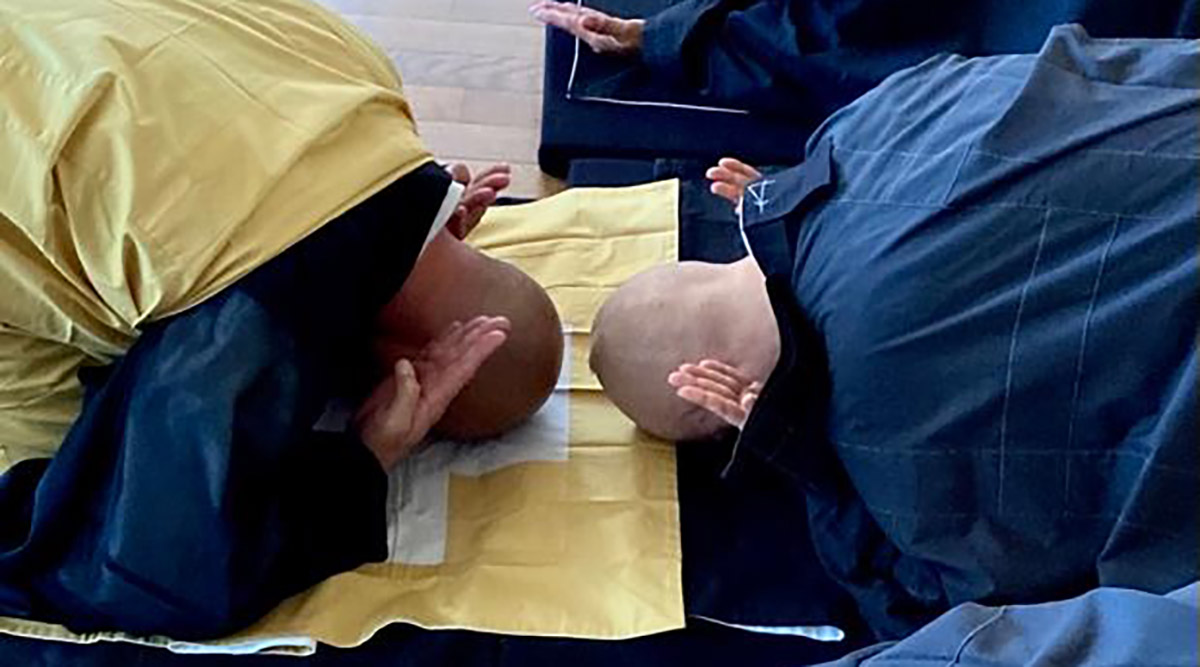
Sanpai
This universal religious gesture symbolizes humility before nature and the entire cosmos.
After practicing zazen, disciples and teacher bow together. They enter into harmony and merge into one spirit. Sanpai transcends the individualistic nature of the human being and opens the way to a higher dimension.
To focus on every stich.
Kesa, or kasaya in Sanskrit, means ochre color, the color of the Earth. It is the robe worn by Zen monks, a symbol of the transmission from master to disciple, and an emblem of the spiritual life.

Kesa
After attaining satori under the Bodhi tree, Shakyamuni Buddha gathered old cloths, washed them, dyed them, and sewed them together. In this way, he made the first kesa, which he wore while practicing zazen.
That kesa was passed on to Mahakashyapa, and then from patriarch to patriarch—from Bodhidharma down to the present day. Dōgen writes: “The kesa is the heart of Zen, the marrow of the bones.”
The kesa, made of rectangular strips of fabric sewn together to resemble rice fields, must be of a dark hue, similar to the color of the earth. The more strips it contains, the more it is revered.
Wearing the kesa allows one to reflect upon oneself and to see one’s true image. The posture of zazen becomes strong, radiating beauty and dignity.
Around 2,500 years ago, a man who would become the Buddha sat beneath a tree in a meditation posture (zazen) and awakened. This original awakening, experienced through zazen, was later transmitted from person to person, across the centuries, until it reached us today.
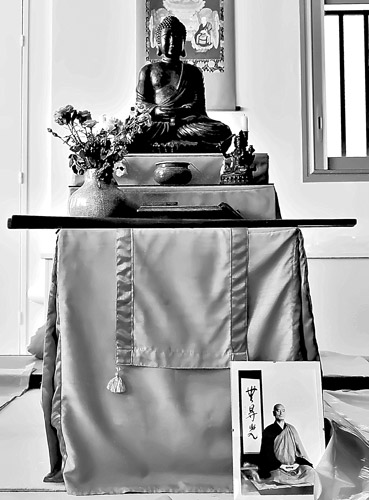
Altar with the Buddha in a dojo
The name of meditation changed as it traveled through different countries: dhyana in Sanskrit, ch’an in China, and finally zen when it arrived in Japan at the end of the 12th century. In each of these countries, Buddhism took on a different face, always managing to adapt and blend with the local culture.
After spreading throughout Asia, Zen reached the United States and Europe in the second half of the 20th century. Today, it remains a living tradition, evolving to meet the challenges of the modern world.
“Theoretical study of Zen has no real influence on us, on our personality. Reading books and acquiring knowledge does not bring about transformation, nor does it help in the search for satori. What truly matters is practice—zazen.” Taisen Deshimaru (1914–1982)
The Way of the Buddha is not studied externally, but through body and mind.
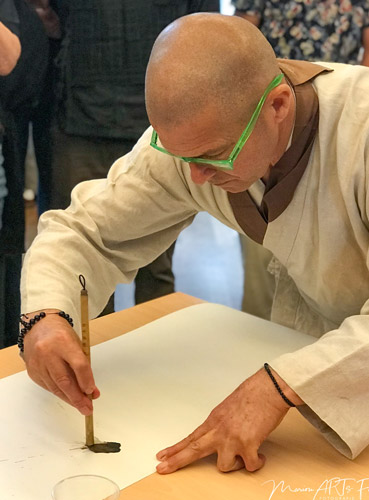
Zen Master Beppe Mokuza Signoritti
True understanding is transmitted through practice and must be reflected in all actions of daily life. Seeking to understand solely through books leads only to relative knowledge.
Suggested Readings: